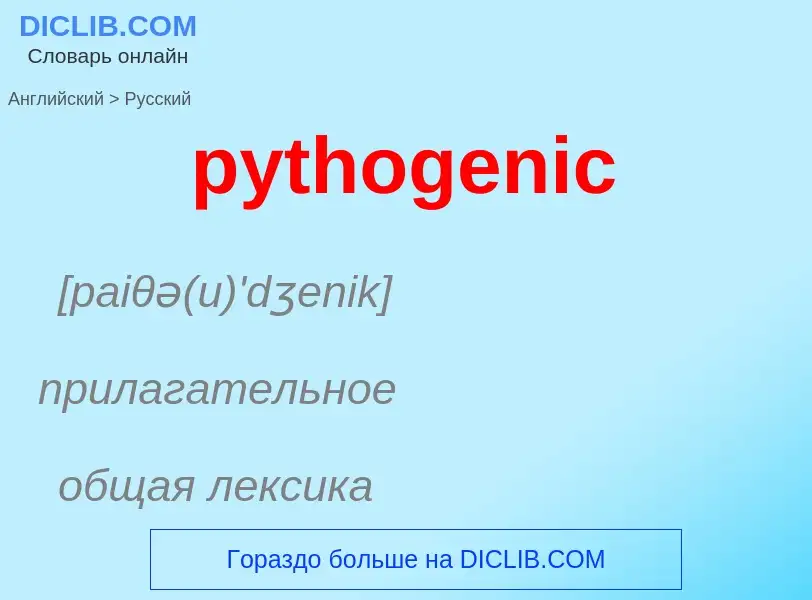Перевод и анализ слов искусственным интеллектом
На этой странице Вы можете получить подробный анализ слова или словосочетания, произведенный с помощью лучшей на сегодняшний день технологии искусственного интеллекта:
- как употребляется слово
- частота употребления
- используется оно чаще в устной или письменной речи
- варианты перевода слова
- примеры употребления (несколько фраз с переводом)
- этимология
pythogenic - перевод на русский
[paiθə(u)'dʒenik]
прилагательное
общая лексика
происходящий от гниения
образующийся при распаде
общая лексика
брюшной тиф
Определение
Википедия

Typhoid fever, also known as typhoid, is a disease caused by Salmonella serotype Typhi bacteria. Symptoms vary from mild to severe, and usually begin six to 30 days after exposure. Often there is a gradual onset of a high fever over several days. This is commonly accompanied by weakness, abdominal pain, constipation, headaches, and mild vomiting. Some people develop a skin rash with rose colored spots. In severe cases, people may experience confusion. Without treatment, symptoms may last weeks or months. Diarrhea may be severe, but is uncommon. Other people may carry the bacterium without being affected, but they are still able to spread the disease. Typhoid fever is a type of enteric fever, along with paratyphoid fever. S. enterica Typhi is believed to infect and replicate only within humans.
Typhoid is caused by the bacterium Salmonella enterica subsp. enterica serovar Typhi growing in the intestines, peyers patches, mesenteric lymph nodes, spleen, liver, gallbladder, bone marrow and blood. Typhoid is spread by eating or drinking food or water contaminated with the feces of an infected person. Risk factors include limited access to clean drinking water and poor sanitation. Those who have not yet been exposed to the pathogen and ingest contaminated drinking water or food are most at risk for developing symptoms. Only humans can be infected; there are no known animal reservoirs.
Diagnosis is by culturing and identifying S. enterica Typhi from patient samples or detecting an immune response to the pathogen from blood samples. Recently, new advances in large-scale data collection and analysis have allowed researchers to develop better diagnostics, such as detecting changing abundances of small molecules in the blood that may specifically indicate typhoid fever. Diagnostic tools in regions where typhoid is most prevalent are quite limited in their accuracy and specificity, and the time required for a proper diagnosis, the increasing spread of antibiotic resistance, and the cost of testing are also hardships for under-resourced healthcare systems.
A typhoid vaccine can prevent about 40% to 90% of cases during the first two years. The vaccine may have some effect for up to seven years. For those at high risk or people traveling to areas where the disease is common, vaccination is recommended. Other efforts to prevent the disease include providing clean drinking water, good sanitation, and handwashing. Until an infection is confirmed as cleared, the infected person should not prepare food for others. Typhoid is treated with antibiotics such as azithromycin, fluoroquinolones, or third-generation cephalosporins. Resistance to these antibiotics has been developing, which has made treatment more difficult.
In 2015, 12.5 million new typhoid cases were reported. The disease is most common in India. Children are most commonly affected. Typhoid decreased in the developed world in the 1940s as a result of improved sanitation and the use of antibiotics. Every year about 400 cases are reported in the U.S. and an estimated 6,000 people have typhoid. In 2015, it resulted in about 149,000 deaths worldwide – down from 181,000 in 1990. Without treatment, the risk of death may be as high as 20%. With treatment, it is between 1% and 4%.
Typhus is a different disease. Owing to their similar symptoms, they were not recognized as distinct diseases until the 1800s. "Typhoid" means "resembling typhus".


![[[Almroth Edward Wright]] developed the first effective typhoid vaccine. [[Almroth Edward Wright]] developed the first effective typhoid vaccine.](https://commons.wikimedia.org/wiki/Special:FilePath/Almroth Wright c1900.jpg?width=200)

![A 1939 conceptual illustration showing various ways that typhoid bacteria can contaminate a [[water well]] (center) A 1939 conceptual illustration showing various ways that typhoid bacteria can contaminate a [[water well]] (center)](https://commons.wikimedia.org/wiki/Special:FilePath/ForskeligeVeje ad hvilkenBroen kan inficeres medTyfusbaciller.png?width=200)



![Doctor administering a typhoid [[vaccination]] at a school in [[San Augustine County, Texas]], 1943 Doctor administering a typhoid [[vaccination]] at a school in [[San Augustine County, Texas]], 1943](https://commons.wikimedia.org/wiki/Special:FilePath/Typhoid inoculation2.jpg?width=200)

